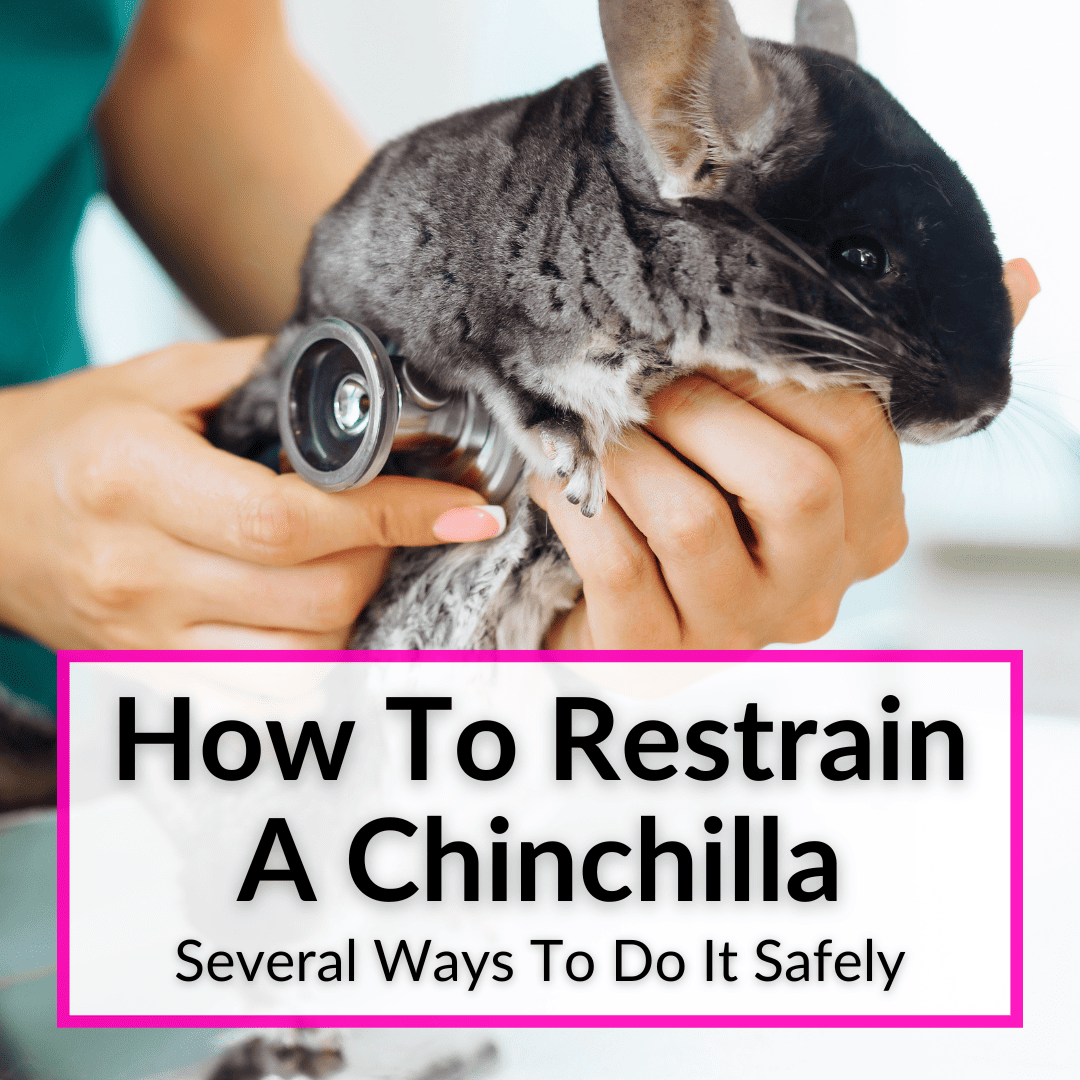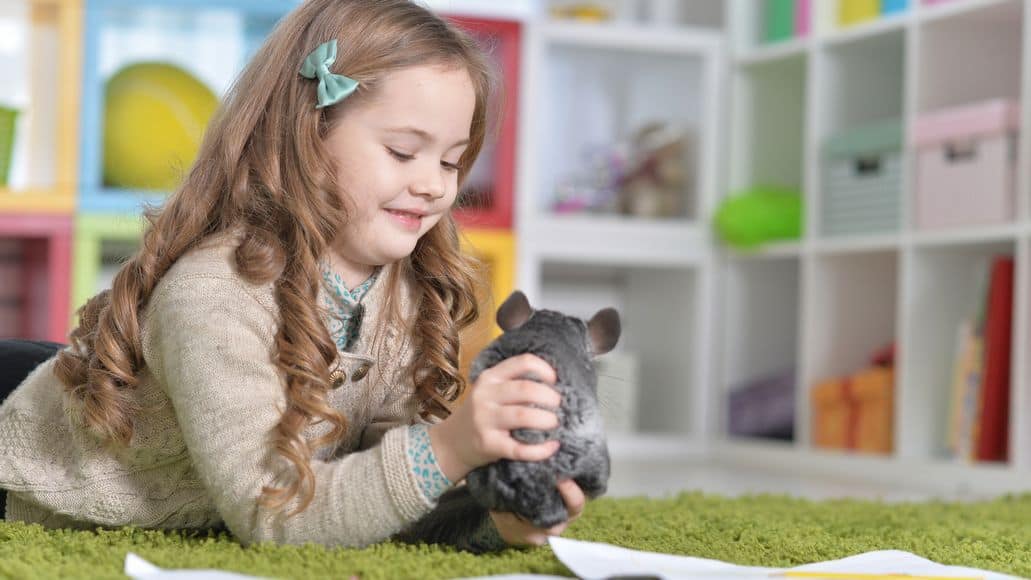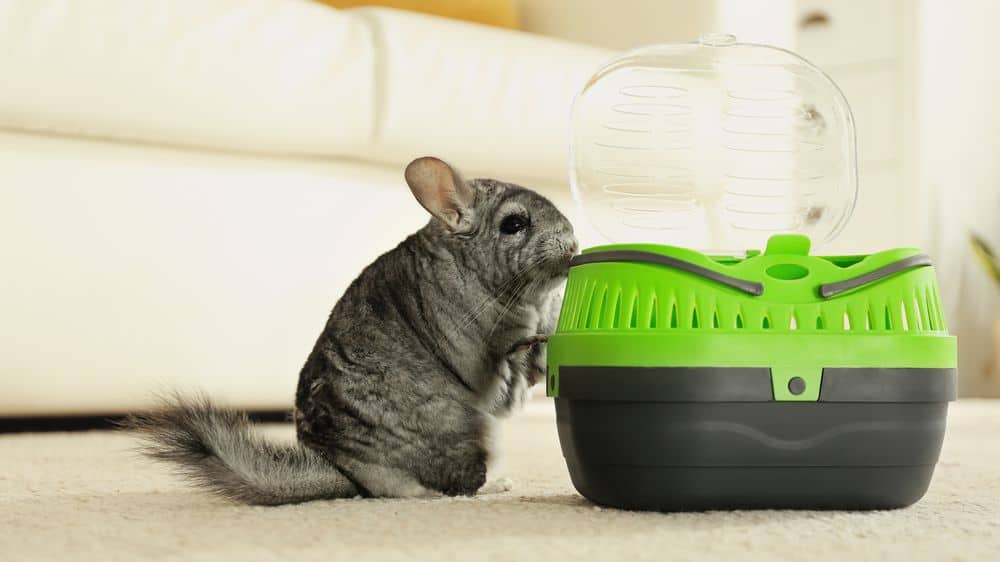
I’m sure that comes as no surprise.
It’s the same for most animals.
Does that mean you should never restrain your chinchilla?
No, definitely not! Sometimes it is necessary for your pet’s safety.
And if you know how to restrain a chinchilla, you can do it safely and minimize any stress on your chin.
So how do you do it? Keep reading to find out. We’ll give you a few different ways to restrain a chinchilla.
Contents
How To Restrain A Chinchilla
Before attempting to restrain your chinchilla, you want to make sure it is calm. To avoid stressing your chinchilla, I suggest approaching it calmly and gently, avoiding sudden movements and noises. Let it sniff and explore you, before attempting to pick it up or hold it.
If it is already stressed and upset, give it some time to calm down. We also have an article on how you can calm a chinchilla down that can help. Once you are ready to restrain your chinchilla, you have a few options.
By The Tail

Restraining a chinchilla by its tail involves grabbing the base of the tail and lifting the animal up. Some people argue that it is a practical way to control a chinchilla and avoid them escaping or causing harm to themselves.
The argument is that wild chinchillas use their tails as a defense mechanism, and domestic chinchillas are no different. Restraining them by their tail mimics one of their natural defense mechanisms, which can prevent them from fleeing, getting tangled up, or even getting hurt.
However, there are many others who believe that restraining a chinchilla by its tail is unethical and harmful. For one, it has the potential to cause severe pain and discomfort to the chinchilla.
Their tail is fragile and can easily become injured or even detach from their body, if you do it wrong. You need to know exactly how to grab a chinchilla by the tail the right way.
This is why many experts recommend that owners never grab their chinchilla by the tail. Additionally, restraining from the tail can cause severe emotional distress to the chinchilla.
The Towel Method
One popular method for restraining chinchillas is by using a towel. The standard way to do this is to place the towel over the animal’s back, with its head and feet gently tucked inside of it. Make sure that you gently cradle your pet’s body to prevent any harm.
This method removes any possible escape routes and gives you control over the situation. Be mindful not to grip your chinchilla too tightly, because this can cause unnecessary stress and anxiety. You could even injure your chinchilla’s delicate bones.
By The Scruff

Another common way to hold a chinchilla is by the scruff of the fur at the back of its neck. This method mimics how a mother chinchilla would carry her young, so it’s a familiar position for the animal.
With this method, always make sure to provide support for the rest of the body by cradling it with your other hand. Never hold your chinchilla by its scruff alone, because this will create unnecessary stress.
Treats
Another trick to restrain your chinchilla is to use treats. This requires some patience. It will probably take some time. You will want to get a treat ready in your hand and use it to get your chinchilla to come towards you.
Once it takes the treat, you can lift it up with your other hand. This trick is the best for motivating your chinchilla through positive reinforcement, which is always a good idea when it comes to chinchilla care. Your pet will eventually come to associate restraint with treats.
Using A Carrier
For those situations when you need to transport your chinchilla, it’s best to use a carrier for your chinchilla. You’ll need a ventilated, securely latched, and transport-friendly crate to keep your chinchilla safe.

Make sure that the carrier is spacious enough and comfortable for your pet. It should be lined with a soft material, like fleece, wood shavings or paper bedding. You can even add a couple of your chinchilla’s favorite toys in there to keep it entertained.
You will need to use a carrier for times when you take your chinchilla to the vet, or to a friend’s or family’s home, if you will be out of town for more than a day or two and your chinchilla needs looking after.
Chinchilla Restraint: Final Thoughts
There is some controversy around this topic, as is to be expected, but if you know how to restrain a chinchilla correctly, it is not a cruel act. In fact, it can be necessary to protect your pet.
And there is not one single right way to do it. There are a number of different ways to restrain a chinchilla, each with its pros and cons. Each of the methods above might appeal to different people, or different ones might work better in different situations.
Leave a Reply